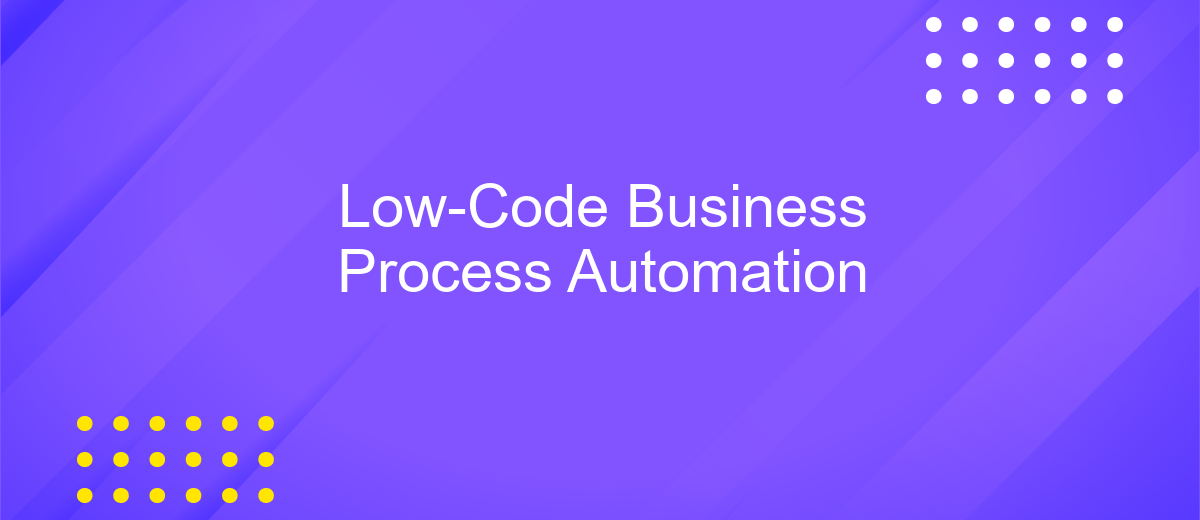Low-Code Business Process Automation
In today's rapidly evolving business landscape, organizations are increasingly turning to low-code platforms for business process automation to enhance efficiency and agility. Low-code solutions empower users to design and implement automated workflows with minimal coding, bridging the gap between IT and business teams. This approach not only accelerates digital transformation but also reduces costs and fosters innovation, enabling companies to stay competitive in a dynamic market.
Understanding Low-Code and Its Role in Business Process Automation
Low-code platforms are revolutionizing the way businesses approach process automation by simplifying the development process. These platforms provide a visual interface that allows users to create applications with minimal hand-coding, making it accessible to those without extensive programming knowledge. This democratization of app development empowers business users to actively participate in automating their processes, reducing the reliance on IT departments and accelerating project timelines.
- Reduced Development Time: Low-code platforms enable rapid application development, significantly cutting down the time required to automate processes.
- Cost Efficiency: By minimizing the need for specialized developers, businesses can reduce costs associated with traditional software development.
- Increased Flexibility: Users can quickly adapt and modify processes as business needs evolve, ensuring continuous improvement.
- Enhanced Collaboration: Low-code tools foster collaboration between IT and business teams, aligning technical solutions with business objectives.
Incorporating low-code solutions into business process automation strategies allows organizations to remain agile and responsive in a fast-paced market. By leveraging these platforms, companies can streamline operations, improve efficiency, and gain a competitive edge. As the demand for rapid digital transformation grows, low-code is poised to become an integral part of the business automation landscape.
Benefits of Low-Code BPA for Businesses

Low-code business process automation (BPA) offers numerous advantages for companies looking to streamline operations and enhance productivity. One of the primary benefits is the significant reduction in development time. By utilizing low-code platforms, businesses can quickly design and deploy applications without the need for extensive coding knowledge. This accelerates the automation of routine processes, allowing teams to focus on more strategic tasks. Additionally, low-code solutions often come with pre-built templates and modules, enabling rapid customization to meet specific business needs.
Another significant advantage is the ease of integration with existing systems. Low-code platforms, such as ApiX-Drive, facilitate seamless connectivity between various applications, ensuring a smooth flow of data across departments. This integration capability minimizes manual data entry and reduces the risk of errors, leading to more efficient and accurate operations. Moreover, low-code BPA empowers non-technical staff to contribute to process improvement, fostering a culture of innovation and agility within the organization. Overall, low-code BPA provides a flexible and cost-effective approach to optimizing business processes.
Key Features to Look for in a Low-Code BPA Platform

When selecting a low-code business process automation (BPA) platform, it's crucial to identify features that enhance efficiency and scalability. These platforms are designed to simplify the automation of complex processes, making it essential to choose one with the right capabilities.
- Drag-and-Drop Interface: A user-friendly interface that allows users to design workflows without extensive coding knowledge.
- Integration Capabilities: Seamless integration with existing systems and third-party applications to ensure smooth data flow.
- Scalability: The ability to grow with your business and handle increased workloads without compromising performance.
- Security Features: Robust security measures to protect sensitive data and ensure compliance with industry standards.
- Customizable Templates: Pre-built templates that can be tailored to specific business needs, accelerating the development process.
By focusing on these key features, businesses can select a low-code BPA platform that not only meets their immediate needs but also supports long-term growth and innovation. This approach ensures that the platform remains a valuable asset as the organization evolves.
Implementing Low-Code BPA: Best Practices and Considerations

Implementing low-code business process automation (BPA) requires a strategic approach to maximize its benefits. First, it's essential to assess the existing processes to identify areas where automation can deliver the most value. Understanding the specific needs and goals of your organization will guide the implementation process effectively.
Next, selecting the right low-code platform is crucial. Evaluate platforms based on their ease of use, scalability, integration capabilities, and support. A platform that aligns with your organization's technical landscape and future growth plans will ensure a smoother implementation and adoption process.
- Engage stakeholders early to gather insights and foster buy-in.
- Start with small, manageable projects to demonstrate value quickly.
- Prioritize security and compliance to protect sensitive data.
- Continuously monitor and optimize automated processes for improvement.
Finally, provide comprehensive training and support to ensure that all users are comfortable with the new system. Encouraging feedback and iterative improvements will help in refining the solution, ensuring it meets evolving business needs. By following these best practices, organizations can effectively leverage low-code BPA to enhance efficiency and drive innovation.


Future Trends and the Evolving Landscape of Low-Code BPA
The future of Low-Code Business Process Automation (BPA) is poised to transform how organizations operate, offering greater flexibility and efficiency. As businesses strive to adapt to rapidly changing environments, low-code platforms will become increasingly integral. These platforms enable users to design, modify, and deploy applications with minimal coding, thus accelerating digital transformation. The rise of AI and machine learning will further enhance low-code BPA, allowing for more intelligent process automation and decision-making capabilities.
In this evolving landscape, integration tools like ApiX-Drive will play a crucial role. By simplifying the process of connecting various applications and services, ApiX-Drive facilitates seamless data flow and operational coherence. As businesses continue to adopt diverse software solutions, the ability to effortlessly integrate these tools will be essential. This trend will drive the demand for more sophisticated, user-friendly integration platforms, ensuring that low-code BPA remains at the forefront of innovation and efficiency in business operations.
FAQ
What is Low-Code Business Process Automation?
How does Low-Code Business Process Automation benefit businesses?
Can Low-Code platforms integrate with existing systems?
What types of processes can be automated using Low-Code platforms?
Is Low-Code Business Process Automation secure?
Routine tasks take a lot of time from employees? Do they burn out, do not have enough working day for the main duties and important things? Do you understand that the only way out of this situation in modern realities is automation? Try Apix-Drive for free and make sure that the online connector in 5 minutes of setting up integration will remove a significant part of the routine from your life and free up time for you and your employees.

